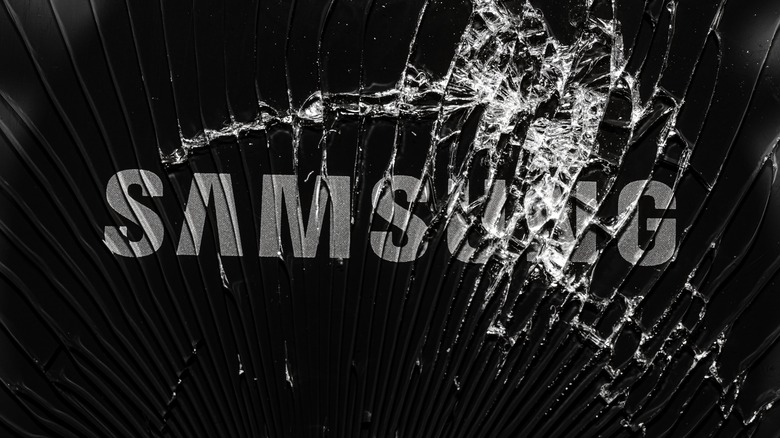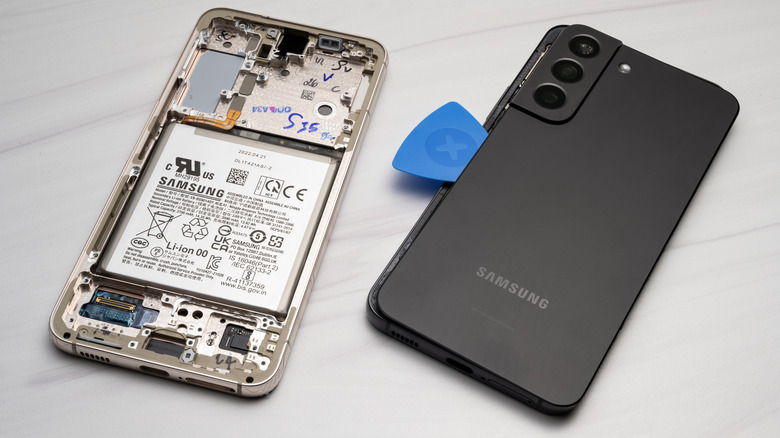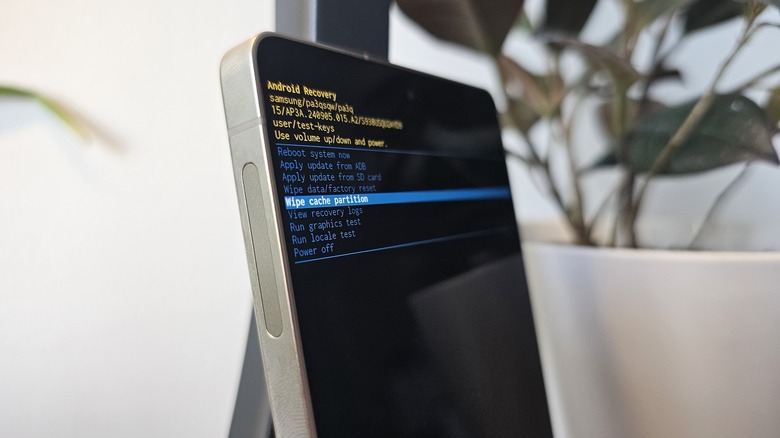Why Samsung Smartphones Are Among The Most Difficult To Repair
In a world where waste is the norm, many people still want to repair their broken gadgets rather than buy new ones. It's often cheaper to replace a single, damaged part than to replace an entire device, and it's also far easier on the environment. But repairability is rarely a priority for tech companies. The problem is particularly pronounced in the smartphone segment, where Apple tends to come in for a lot of criticism. Sure enough, the most difficult modern phone to repair comes courtesy of Cupertino. However, many other companies deserve equal scrutiny for anti-consumer design choices, and we need to look no further than Apple's largest competitor in the smartphone market for an example.
Samsung smartphones are among the most difficult to repair, according to consumer repair advocates. The company is a global juggernaut that makes dozens of different smartphones yearly for various markets, and it has developed a streamlined design across many of its phones, which undoubtedly speeds up production. Whether you crack open the premium Galaxy 25 Ultra or the budget-conscious Galaxy A16, the basic construction is the same. The phone's internals are arranged inside a central frame, with a sheet of glass or plastic glued to the back and a screen glued to the front.
Some people find Samsung phones boring to look at, while others admire their design. To someone whose job is repairing mobile gadgets, though, all they see is a major headache. From stubborn adhesives to specially shaped screens, several issues make fixing Samsung phones a frustrating affair. Let's break down why.
Samsung's glass sandwich design is pretty (and pretty hard to repair)
To get a better understanding of what makes simple Samsung Galaxy repairs like battery and screen replacements difficult, let's first go over what would make them easy. A decade ago, Samsung's smartphones had removable backplates with quick access to the battery. Even so, the Galaxy S5 was water resistant, a year before Samsung switched to a unibody design with the Galaxy S6. Samsung's unibody phones look and feel more premium, but they're leagues more difficult to repair.
Today, accessing a Samsung phone's battery or removing its display requires applying heat to the glued-on backplate, then prying it open carefully to avoid breaking anything. Samsung's adhesive secures the phone's screen and backplate, but it's also integral to the IP water and dust resistance rating. That glue is very strong, which is one reason why DIY repair group iFixit gave the Galaxy S23 Ultra a dismal repairability rating of 4 out of 10. For comparison, the iPhone 16 received 7 out of 10, with points docked for using multiple types of screws.
A related inconvenience involves the iconic curved displays that shipped on many Galaxy flagships until recently. These screens looked impressive and futuristic at first, but the curves created annoying reflections and made them difficult to repair. Thankfully, that annoyance has been recently remedied. That said, the Samsung repair situation was bad enough that iFixit ended a two-year partnership with Samsung in 2024, claiming that the company made its official parts so expensive that a large number of users eschewed repairs and bought new devices. Also, there was still too much glue.
Samsung's newest phones are slightly more repair-friendly
Samsung's recent hardware has introduced minor repairability improvements. This year's Galaxy S25 Ultra has improved on two of the biggest pain points. The Galaxy S24 Ultra flattened the display, making it easier to remove, and the S25 Ultra has followed suit. Meanwhile, a new pull-tab system makes the battery much easier to remove, reducing the chance of damaging other components while removing it. This led iFixit to award the S25 Ultra with the best repairability score any Samsung phone has received in years: a whopping 5 out of 10.
Repairability is an issue across the tech industry, and Samsung is far from unique. In addition to physical repair barriers, there's an ugly reality to iPhone repairs, too. Apple is notorious for using serialized parts. If you don't get your repair done with Apple's official parts, you may find your iPhone simply stops working. But don't worry! Apple's recently introduced Self Service Repair program will happily let you fix the gadgets you own... if you let them put a $1,200 hold on your credit card so they can mail you a bunch of tools that damage your phone even further when you make a mistake, as a New York Times reporter found out.
Unfortunately, there aren't many superior options. The Fairphone 6 is a repairability advocate's dream device, but it has a mid-range processor. Still, as large companies continue to act adversarially toward users who want to tinker with their tech, it's worth remembering that every aspect of a smartphone was a deliberate choice made by its manufacturer, for better or worse.


